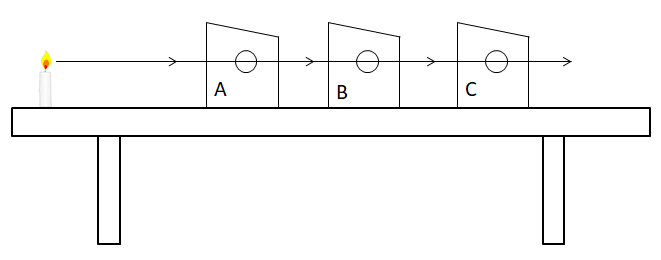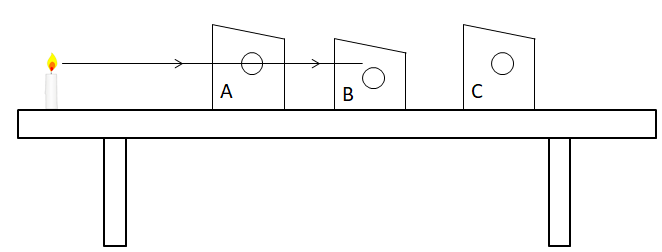
Explain an experiment to show the rectilinear propagation of light.
Answer
505.8k+ views
1 likes
- Hint: Write down the definition of rectilinear propagation of light, then analyze accordingly. The homogeneous medium causes the refractive index of the medium to remain constant throughout. The experimental setup consists of three cardboard boxes having holes in the same place kept distances apart in a straight line on top of a table. On one end of the table is a candle and from the other end, we will try to view the candle.
Complete step-by-step solution -
Let’s start by understanding the rectilinear propagation. The rectilinear propagation of light which is an electromagnetic wave, is the tendency of light waves to travel in a straight line. We must also remember that a light wave deviates from a straight line when the medium in which the light wave is travelling is not homogeneous. Whenever, there is a change in the refractive index of the medium due to the inhomogeneous medium, the light wave will deviate from its path.
To prove that the light wave travels in a straight line throughout a homogeneous medium (a medium containing a constant refractive index throughout the medium), that is rectilinear propagation of light, we will consider a small experiment.
We will consider a setup containing, a table having a candle at one end of the table and three cardboard pieces having holes cut out at the same position placed at different distances on the table in a straight line as in the diagram below.

Since, all the holes are aligned in a straight line at the same level with the candle, hence a viewer on the other end of the table will be able to see the candle through the holes initially.
Now let’s consider, the cardboard labelled B is displaced by a small distance.

Now, when we try to view the candle from one end of the candle through the holes, we will be unable to see the candle. Since, the displaced cardboard causes the light travelling in a straight line to get obstructed by the cardboard B.
Hence, we can confirm that the light wave follows rectilinear propagation.
Note: The light can also bend during the process of diffraction. However, this process happens rarely and can only occur when the light wave of a single wavelength travelling is obstructed by an obstacle having the same order as that of the wavelength of light.
The bending of light in refraction phenomenon, occurs due to change in the velocity of the light due to the medium. Hence, whenever the light passes through a denser medium as compared to vacuum, its velocity becomes:
Complete step-by-step solution -
Let’s start by understanding the rectilinear propagation. The rectilinear propagation of light which is an electromagnetic wave, is the tendency of light waves to travel in a straight line. We must also remember that a light wave deviates from a straight line when the medium in which the light wave is travelling is not homogeneous. Whenever, there is a change in the refractive index of the medium due to the inhomogeneous medium, the light wave will deviate from its path.
To prove that the light wave travels in a straight line throughout a homogeneous medium (a medium containing a constant refractive index throughout the medium), that is rectilinear propagation of light, we will consider a small experiment.
We will consider a setup containing, a table having a candle at one end of the table and three cardboard pieces having holes cut out at the same position placed at different distances on the table in a straight line as in the diagram below.

Since, all the holes are aligned in a straight line at the same level with the candle, hence a viewer on the other end of the table will be able to see the candle through the holes initially.
Now let’s consider, the cardboard labelled B is displaced by a small distance.

Now, when we try to view the candle from one end of the candle through the holes, we will be unable to see the candle. Since, the displaced cardboard causes the light travelling in a straight line to get obstructed by the cardboard B.
Hence, we can confirm that the light wave follows rectilinear propagation.
Note: The light can also bend during the process of diffraction. However, this process happens rarely and can only occur when the light wave of a single wavelength travelling is obstructed by an obstacle having the same order as that of the wavelength of light.
The bending of light in refraction phenomenon, occurs due to change in the velocity of the light due to the medium. Hence, whenever the light passes through a denser medium as compared to vacuum, its velocity becomes:
Latest Vedantu courses for you
Grade 11 Science PCM | CBSE | SCHOOL | English
CBSE (2025-26)
School Full course for CBSE students
₹41,848 per year
Recently Updated Pages
Master Class 9 General Knowledge: Engaging Questions & Answers for Success

Master Class 9 English: Engaging Questions & Answers for Success

Master Class 9 Science: Engaging Questions & Answers for Success

Master Class 9 Social Science: Engaging Questions & Answers for Success

Master Class 9 Maths: Engaging Questions & Answers for Success

Class 9 Question and Answer - Your Ultimate Solutions Guide

Trending doubts
Give 10 examples of unisexual and bisexual flowers

Draw a labelled sketch of the human eye class 12 physics CBSE

Differentiate between homogeneous and heterogeneous class 12 chemistry CBSE

Differentiate between insitu conservation and exsitu class 12 biology CBSE

What are the major means of transport Explain each class 12 social science CBSE

Why is the cell called the structural and functional class 12 biology CBSE




